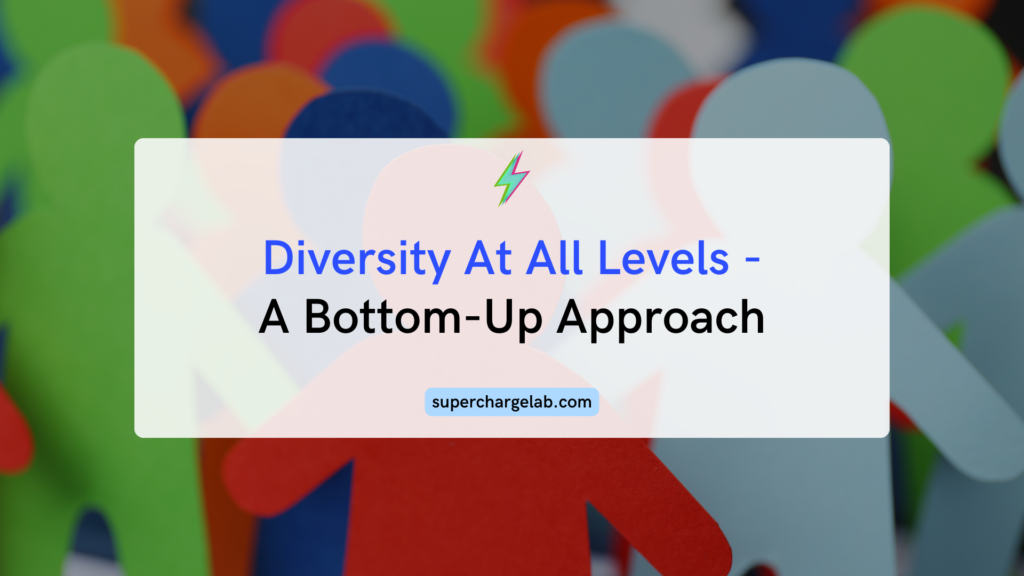
Introduction :
Accepting diversity is becoming more than just a box to check in today’s changing business environment—it is a strategic imperative. It is difficult for homogenous teams to innovate, negotiate challenging markets, and establish genuine connections with a wide range of clients. However, conventional top-down diversity programs frequently fall short, seeming forced and unable to spark real cultural transformation. The bottom-up method is a paradigm shift that enables every employee in an organization to promote inclusivity and create a workforce that is representative of the diversity of the world. In a world where diversity is the new currency, this grassroots movement offers not merely met quotas but also a dynamic tapestry of perspectives woven into the company’s fundamental fabric, fueling innovation, encouraging belonging, and accelerating success.
The Power of the Grassroots :
A bottom-up approach to D&I that changes the script and offers every employee the ability to be an architect of cultural change is the genuine game-changer. In contrast to conventional hierarchical frameworks, which frequently depend on directives and targets, this change in viewpoint acknowledges that each person’s unique experiences and varied viewpoints serve as the fundamental components of an inclusive organization.
Imagine working for a company where everyone feels empowered to support diversity and inclusion initiatives, from the intern in the corner brainstorming to the seasoned executive in the boardroom. This might be the member of the marketing team suggesting inclusive language guidelines, the junior developer leading an unconscious bias training course, or the engineer creating a department-wide mentorship program to link varied talent. These kind of natural initiatives, driven by sincere enthusiasm and comprehension, get woven into the organization’s fabric and create a sense of community that goes beyond simple adherence.
Instead of rejecting leadership, the goal of this bottom-up strategy is to create a cooperative ecosystem in which workers sow the seeds of change and leadership provides the resources and fertile ground. What was the outcome? In a world where inclusivity is the ultimate competitive advantage, a dynamic weave of ideas constructed from the many strands of lived experiences will ultimately move the organization forward, spurring innovation and drawing and keeping the best talent.
Google’s Bottom Up Approach :
The success of Google serves as evidence of the value of a bottom-up strategy. Rather than impeding inventiveness with inflexible directives, they enable their heterogeneous staff to function as the creative symphony. This fosters the free flow of ideas that result in a symphony of unanticipated discoveries in a variety of industries.
Google’s bottom-up strategy gave rise to digital giants like Android in mobile, Chromebooks in personal computing, and Google Home in voice assistance, all from its modest origins in search and advertising. It’s not as though there has been a perfect track record; attempts at social networking and modular phones have failed. Even so, these “off-key notes” help Google learn and grow, enabling it to tweak and adapt remarkably quickly.
This flexibility, nevertheless, can also result in a complicated melody. For example, Google’s messaging ecosystem is like a group of shelved projects: Talk, Hangouts, Allo, Duo, and so on, leading up to the present Google Meet. Although some could argue this is a lack of focus, it really emphasizes the bottom-up approach’s inherent dynamism. Google encourages experimentation by letting different teams pursue ideas, even when they conflict. This encourages quick iterations and course corrections, which eventually helps them become a leader in innovation.
While Google’s strategy may not be a masterfully choreographed, it is a dynamic, constantly-changing improvisation. It all comes down to empowering people, taking lessons from mistakes and achievements, and building a tech ecosystem that is fueled by the inventiveness of its varied workforce as a whole.
Amplifying the Impact :
Although the bottom-up approach’s organic character gives it force, leadership support is necessary for it to work as a cohesive whole. It is the role of leaders to be cultivators, creating the ideal environment for employee-driven projects to thrive. This entails doing more than simply assigning funds; it also entails actively supporting diversity and inclusion initiatives, attending training sessions, and establishing a welcoming atmosphere. Clear lines of communication, frequent feedback loops, and sincere gratitude for staff contributions serve as the raindrops that nourish initiatives and turn them into meaningful transformations.
Conclusion:
Diversity is no longer a box to be checked but rather the orchestra conductor propelling success and innovation in the ever-changing business world. Conventional hierarchical methods frequently fall short, whereas the bottom-up approach enables each employee to become an expert in inclusion. This is also true of Google’s story, as employee-driven initiatives weave a rich tapestry that gives rise to digital greats like Chromebooks and Android.
Are you prepared to let diversity in your workplace? Join us for a comprehensive discussion of www.calendly.com/annecheng , where we’ll explore the benefits of a bottom-up approach in greater detail, and start a cooperative dialogue about creating a truly inclusive workplace.